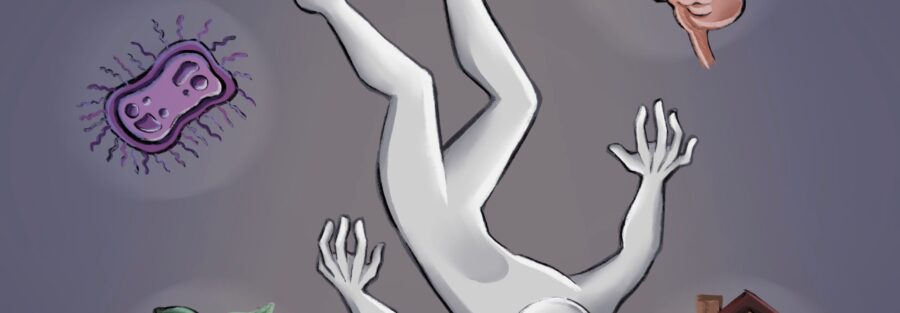Did you know that falls are the leading cause of injury among older Canadians? That’s a scary thought – it’s easy to think that injuries are from ‘more serious’ causes like motor vehicle accidents or in the workplace, but that’s not necessarily true. 20-30% of seniors fall once or more each year, which results in 95% of annual hip fractures. Importantly, half of these life-altering falls occur within the home space.
These are some scary facts, but we are here to give you information on common risk factors for falls, and importantly strategies to avoid them. Knowledge is prevention, and prevention is the best medicine!
There are many different risk factors that could increase the likelihood of experiencing a dangerous fall. So many so, that they are typically categorized into one of 4 different types. Each person faces their own unique combination of risk factors:
Biological risk factors are those related to the natural aging process and existing health conditions. Some of these are modifiable through lifestyle modification/treatments:
- Acute Illness: fever, nausea, dizziness, infections (UTIs), as well as the medications prescribed to treat these conditions
- Balance and Gait Deficits: biomechanical, sensory and cognitive changes
- Chronic Conditions: neurological, diabetes, arthritis, cardiovascular, etc.
- Cognitive Impairments: dementia and delirium can increase your risk by 2-3 times due to its ability to affect how you anticipate and adapt in situations
- Low Vision: increases your risk by 2.5x
- Muscle Weakness: reduced physical activity and endurance has been shown to be the most important risk factor, increasing your risk of falls by 4-5x
Behavioural risk factors are the actions, emotions, and choices of the individual. Most of these are manageable with proper planning ahead & open discussion of alternatives:
- Assistive Devices: are they properly maintained, are you comfortable using it?
- Fear of Falling: 34% of people over 65 have a fear of falling and due to this they decrease their levels of physical activity
- Footwear/ Clothing: shoes design, long clothing
- Previous History of Falls: strong predictor
- Inadequate Diet: dehydration, malnutrition
- Medications: older adults taking 3-4 medications are at a higher risk of falls
- High-Risk Behaviour: climbing ladders, leaving clutter in the way in walking paths
Social and Economic risk factors are the connection between social determinants and one’s level of disability, development of chronic conditions, longevity, etc.
- Social Networks: studies show a positive effect between strong family networks and lower fall rates
- Socio-economic: low education and health literacy
Environmental risk factors are those associated with the physical environment. These are perhaps the ‘easiest’ to modify, given proper planning ahead and careful observation:
- 40-60% of all falls are related to environmental hazards
- Factors in the community: poor stair design, lack or lighting, handrails, uneven pavement
- Factors in the living environment: throw rugs, electrical cords, cluttered floors, bathtubs, etc.
- Weather and climate: wet and icy surfaces
Now that you know some common risk factors that lead to falls, we will go over the different interventions that can help prevent them!
The #1 intervention for preventing falls is exercise. This includes balance and gait training, strength training, Tai chi, etc. Studies have shown that exercise leads to a lower rate of falls, a lower number of fallers, a lower rate of fall related fractures and a lower rate of falls requiring medical attention. Having a mobility assessment done and problem solving on removing physical activity limitations can be a good place to start on your exercise journey. Fitness and exercise class orientations can also be a good way to become comfortable with this. As well, you can always come into Halton Chiropractic Clinic to learn different balance and strength principles and exercises from our chiropractors in a safe and controlled setting so we can set you up for success in your daily life.
Another important step to take would be reviewing the medication you take with your pharmacist and family physician. It is important to learn about the different reactions you may experience with these medications and get advice on risk factors related to them.
Nutritional assessments will also be an important factor to ensure that all the elements needed to help prevent and avoid falls – that is, your mind & your muscles – have the necessary energy requirements to function properly. Also, don’t neglect your water intake! A nutritional assessment can help problem solve, manage, and screen for any deficiencies and provide you with advice going forward on diet and supplementation.
Having an environmental and assistive technology review is also a very helpful tool to prevent falls. A home assessment can point out potential trip hazards and provide recommendations to keep you safe. Reviewing all assistive devices and technologies regularly to ensure you are using them correctly and are comfortable will ensure that they are providing the support you require.
There many factors that need to be considered to keep you safe & reduce the rate of falls. Please, call the clinic and book into see one of our chiropractors for a free consultation who would be more than happy to discuss this with you further.
Stay safe!
The Halton Chiropractic Team
References:
- Public Health Agency of Canada [Internet]. Ottawa (ON). [cited 2021 Nov15]. Available from: https://www.canada.ca/en/public-health/services/health-promotion/aging-seniors/publications/publications-general-public/you-prevent-falls.html#facts
- Public Health Agency of Canada. Seniors’ falls in Canada: second report [Internet]. Ottawa (ON): Public Health Agency of Canada; 2014 [cited 2021 Nov15]. Available from: http://www.phac-aspc.gc.ca/seniors-aines/publications/public/index-eng.php
- Sherrington C, Fairhall NJ, Wallbank GK, Tiedemann A, Michaleff ZA, Howard K, Clemson L, Hopewell S, Lamb SE. Exercise for preventing falls in older people living in the community. Cochrane database of systematic reviews. 2019(1)
- Hopewell S, Adedire O, Copsey BJ, Boniface GJ, Sherrington C, Clemson L, Close JC, Lamb SE. Multifactorial and multiple component interventions for preventing falls in older people living in the community. Cochrane Database of Systematic Reviews. 2018(7).






